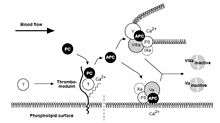Activated protein C resistance
| Activated protein C resistance (APCR) | |
|---|---|
| Classification and external resources | |
| ICD-9-CM | 289.81 |
| OMIM | 188055 |
| MeSH | D020016 |
Activated protein C resistance (APCR) is a hemostatic disorder characterized by a poor anticoagulant response to activated protein C (APC). This results in an increased risk of venous thrombosis, which can cause problems with circulation, such as pulmonary embolism.[1]
The disorder can be acquired or inherited, the hereditary form having an autosomal dominant inheritance pattern.[2]
Pathophysiology

Activated protein C (with protein S as a cofactor) degrades Factor Va and Factor VIIIa. Activated protein C resistance is the inability of protein C to cleave Factor Va and/or Factor VIIIa, which allows for longer duration of thrombin generation and may lead to a hypercoagulable state. This may be hereditary or acquired.[3] The best known and most common hereditary form is Factor V Leiden. Acquired forms occur in the presence of elevated Factor VIII concentrations.
Associated conditions
An estimated 64 percent of patients with venous thromboembolism may have activated protein C resistance.[4]
References
- ↑ Dahlbäck B (2003). "The discovery of activated protein C resistance". J. Thromb. Haemost. 1 (1): 3–9. doi:10.1046/j.1538-7836.2003.00016.x. PMID 12871530.
- ↑ Koster T, Rosendaal FR, De Ronde H, Briët E, Vandenbroucke JP, Bertina RM (December 1993). "Venous thrombosis due to poor anticoagulant response to activated protein C: Leiden Thrombophilia Study". Lancet. 342 (8886–8887): 1503–6. doi:10.1016/S0140-6736(05)80081-9. ISSN 0140-6736. PMID 7902898.
- ↑ Nicolaes GA, Dahlbäck B (2003). "Congenital and acquired activated protein C resistance". Semin Vasc Med. 3 (1): 33–46. doi:10.1055/s-2003-38331. PMID 15199491.
- ↑ Sheppard DR (2000). "Activated protein C resistance: the most common risk factor for venous thromboembolism". J Am Board Fam Pract. 13 (2): 111–5. doi:10.3122/15572625-13-2-111. PMID 10764192.